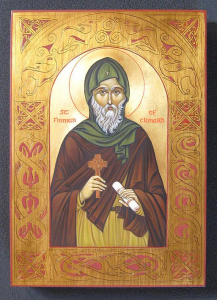 Saint Finnian
Saint Finnian
Bishop in Ireland († 552)
Feast Day – December 12
Recorded Irish history begins with the introduction of Christianity and Latin literacy, beginning in the 5th century or possibly slightly before. The population was entirely rural and dispersed, with small ring fortresses. In this environment, the task of making Ireland Christian was placed upon St. Patrick’s shoulders, but to continue his work St. Finnian was called.
St. Finnian was born around the year 470 at Myshal in County Carlow, on the slopes of Mount Leinster. His father was Rudraigh, an Ulsterman of noble lineage. His mother was a woman called Telach. Finnian was first educated by Bishop Fortchernn, the local bishop. Having an ardent desire to make greater progress, he went to Wales, where he met and conversed with Saint David, Saint Gildas and Saint Cathmael, three eminent British Saints. He also travelled to France where he studied for a time at the Abbey of Marmoutier, just outside the present-day city of Tours. After spending thirty years in Britain, he may have intended to go to Rome, but instead returned to Ireland about the year 520, excellently qualified by his sanctity and sacred learning to cultivate the spirit of religion among his countrymen. Like a loud trumpet sounding from heaven, he roused the insensibility and inactivity of the lukewarm, and softened the most hardened hearts, long immersed in worldly business and pleasures.
His first stop was at Aghowle near Shillelagh in the County of Wicklow, where King Oengus of Leinster gave him a site to build a church. From there he went north to Dunmanogue on the river Barrow, in the County of Kildare, and established another church. Then he travelled to the town of Kildare, studying and teaching at St Brigid’s monastery.
To propagate the work of God, Saint Finnian established several monasteries and schools, chief among which was the monastery of Clonard, where he built a little cell and a church of clay and wattle, a monastery modelled on the practices of Welsh monasteries and based on the traditions of the Desert Fathers. From this school came several of the principal Saints and Doctors of Ireland: Kiaran the Younger, Columkille, Columba son of Crimthain, the two Brendans, Laserian, Canicus or Kenny, Ruadan, and others. The great monastery of Clonard was a famous seminary of sacred learning.
St. Finnian’s gift for teaching and his absolute dedication to the ascetic ideal drew students from various parts of Europe. It is estimated that at one time there were no fewer than 3,000 pupils getting instruction in the school situated in the green fields of Clonard. The master excelled in exposition of the Sacred Scriptures, and this fact explains the extraordinary popularity of his lectures. Many others took seeds of knowledge from St. Finnian’s monastery at Clonard and planted them abroad with great success. St. Finnian was eventually chosen and consecrated Bishop of Clonard. Out of love for his flock and by his zeal for their salvation, he became infirm with the infirm and wept with those that wept. He healed souls as well as the physical infirmities of those who came to him for assistance. His food was bread and herbs, his drink, water, and his bed, the ground, with a stone for his pillow. He departed to Our Lord on the 12th of December in 552.
References and Excerpts:
[1] “Saint Finnian or Finan, Bishop in Ireland.” https://sanctoral.com/en/saints/saint_finnian_or_finan.html (accessed Dec. 03, 2021).
[2] “Dec 12 – St Finnian (d. 539) abbot of Clonard,” Catholicireland.net. https://www.catholicireland.net/saintoftheday/st-finnian-d-539-abbot-of-clonard/ (accessed Dec. 03, 2021).
[3] “Finnian of Clonard,” Wikipedia. Oct. 06, 2021. Accessed: Dec. 03, 2021. [Online]. Available: https://en.wikipedia.org/w/index.php?title=Finnian_of_Clonard&oldid=1048467139